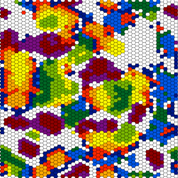MODUS Seminar Program
Weekly talks in the MODUS Seminar in the summer semester 2024:
Wednesday, 12:15-13:45, Room S102, FAN-B
Individual talks may be held via zoom or at different times, see the information, below.
The list of talks is still incomplete and further talks will be added.
To receive email notifications about upcoming talks, please subscribe to the MODUS elearning course.
24.04.2024, 12:15h
Julia Slipantschuk
Dynamical Systems and Data, Universität Bayreuth
Transfer operators and applications
Abstract: A fruitful approach for providing effective statistical descriptions of chaotic dynamical systems is to lift the dynamics to linear evolution operators on infinite dimensional Banach spaces. Spectral data of these operators, known as Koopman or transfer operators, yield insight into the long-term behaviour of the underlying system. In this talk I will give a short introduction into the spectral theory of transfer operators associated to (mostly) low-dimensional discrete chaotic dynamical systems, and present a complete description of eigenvalues of these operators for a certain special class of non-linear maps. In general, such explicit descriptions of eigendata are rarely available, and in various applications algorithms or numerical schemes to approximate these are required. I will present strong spectral convergence and consistency results for a popular numerical approximation scheme -- extended dynamic mode decomposition (EDMD) -- applied to examples of chaotic systems given by one-dimensional expanding maps.
Monday, 6.05.2024, 10:30h, S102
Talk in the lecture series Scientific Computing, Coffee and Tea at 10:00h
Luca Bonaventura
Dipartimento di Matematica, Politecnico di Milano, Italy
A deeper look at shallow water models
Abstract:
The derivation of the classical hydrostatic, vertically averaged shallow water
equations will be presented and revisited to highlight typical conceptual errors. The choice
of time scales determined implicitly by the identification of standard flow regimes will be
discussed. Examples of non-hydrostatic shallow water models will be presented and the
prospects for their rigorous derivation will be discussed.
8.05.2024, 12:15h
Jirka Vomlel
Institute of Information Theory and Automation, Academy of Sciences of the Czech Republic and Faculty of Arts, Charles University, Prague
Uncovering Relationships: Using Bayesian Networks to Analyze Open-Minded Thinking and Conspiracy Beliefs in Czech University Candidates
Abstract:
I will begin with a brief introduction to one of the glass-box models of artificial intelligence called Bayesian Networks (BNs), a model named after the English statistician Rev. Thomas Bayes. BNs represent a probabilistic model that can help visualize relationships between variables. I will illustrate the use of Bayesian networks on data from a Czech university entrance exam. This data included a test of open-minded thinking designed by Jonathan Baron and also examined students' attitudes towards various conspiracies. Using BNs, we can identify conspiracy clusters and their relationships with open-minded thinking.
15.05.2024, 12:15h
April Herwig
AG Numerik komplexer Systeme, TU München
An introduction to pseudospectra and application to validated computational dynamics
12.06.2024, 12:15h
Lisa Jagau
Lehrstuhl Scientific Computing, Universität Bayreuth
Hydrodynamische Modellierung von Mikroplastik-Transport und Sedimentierung in Seen
Abstract:
Mikroplastikpartikel (MP) sind für Organismen in der Hydrosphäre potenziell schädlich. Um die Exposition und das damit verbundene Risiko besser einschätzen zu können, muss das Transport- und Sedimentierungsverhalten von MP in aquatischen Systemen quantifiziert werden. Wir erstellen ein dreidimensionales hydrodynamisches Modell und validieren dieses anhand gemessener Daten für den Großen Brombachsee. Anschließend nutzen wir das Modell, um MP-Transport und Sedimentierung zu modellieren.
Unser Schwerpunkt ist die Modellierung von Polymeren mit unterschiedlichen Dichten und Partikelgrößen, um Muster der Partikelverweilzeit und Sedimentierung zu identifizieren. Die Verteilung von MP im Rechengebiet wird sowohl von der Partikeldichte als auch von der Partikelgröße stark beeinflusst. Kleinere, leichtere Partikel verteilen sich über die gesamte horizontale Ausdehnung des Sees und Partikel mit höherer Dichte oder größerem Durchmesser setzen sich in einem begrenzten Bereich um den Einströmungsort ab, was auf eine höhere Absetzgeschwindigkeit hindeutet.
3.07.2024, 12:15h
Alfred Wassermann
Lehrstuhl Mathematik und ihre Didaktik, Universität Bayreuth
Titel wird noch bekannt gegeben

